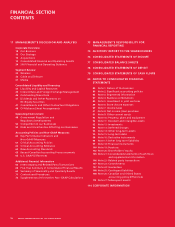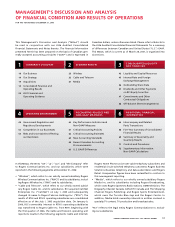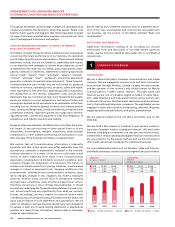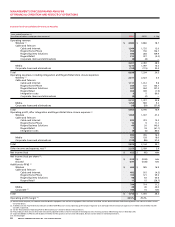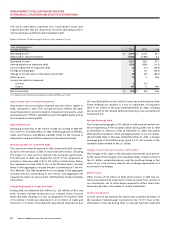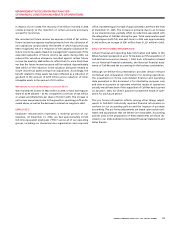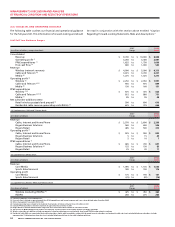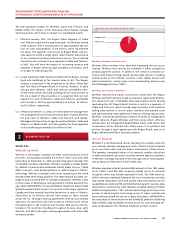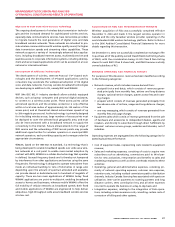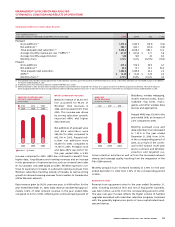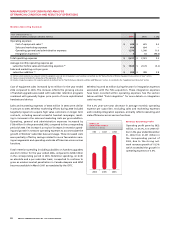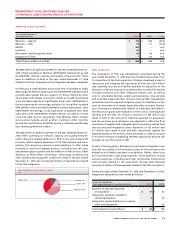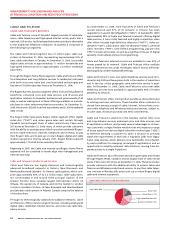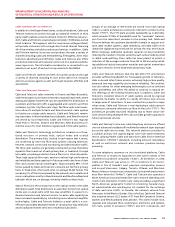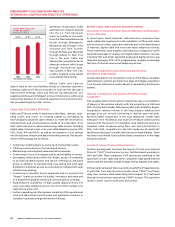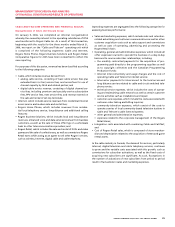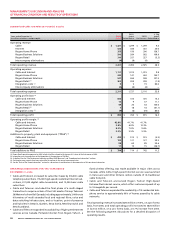Rogers 2006 Annual Report Download - page 30
Download and view the complete annual report
Please find page 30 of the 2006 Rogers annual report below. You can navigate through the pages in the report by either clicking on the pages listed below, or by using the keyword search tool below to find specific information within the annual report.
26 ROG ERS CO MMU N ICAT ION S IN C . 20 0 6 ANN UA L RE PORT
MANAGEMENT’S DISCUSSION AND ANALYSIS
OF FINANCIAL CONDITION AND RESULTS OF OPERATIONS
Fido’s wireless network was also a GSM-based network operating
on the 1900 MHz frequency band. During 2005, Wireless completed
the process of integrating the Rogers Wireless and Fido GSM/GPRS
networks. This network integration enabled Wireless to increase the
density and quality of its wireless coverage while also reducing costs
through the elimination of redundant cell sites and other network
facilities.
Including the acquired Fido spectrum, Wireless holds 25 MHz of
contiguous spectrum across Canada in the 850 frequency range
and 60 MHz in the 1900 frequency range across the country with
the exception of Southwestern Ontario, Northern Quebec, and the
Yukon, Northwest and Nunavut territories where Wireless holds
50 MHz in the 1900 frequency range.
Wireless also holds certain broadband fixed wireless spectrum in the
2300 MHz, 2500 MHz and 3500 MHz frequency ranges. In September
2005, Wireless, together with Bell Canada, announced the formation
of an equally-owned joint venture called Inukshuk to construct a
pan-Canadian wireless broadband network that will be based on the
evolving World Interoperability for Microwave Access (“WiMAX”)
standards. Both companies have contributed fixed wireless spectrum
holdings to the joint venture, along with access to their respective
cellular towers and network backhaul facilities. The fixed wireless
network acts as a wholesale provider of capacity to each of the joint
venture partners who in turn market, sell, support and bill for their
respective service offerings over the network.
WIRELESS STRATEGY
Wireless’ goal is to drive profitable subscriber and revenue growth
within the Canadian wireless communications industry, and its strat-
egy is designed to maximize cash flow and return on invested capital.
The key elements of its strategy are as follows:
• Enhancing its scale and competitive position in the Canadian wire-
less communications market;
• Focusing on voice and data services that are attractive to youth,
families, and small and medium-sized businesses to optimize its
customer mix;
• Delivering on customer expectations by improving handset reli-
ability, network quality and customer service while reducing
subscriber deactivations, or churn;
• Increasing revenue from existing customers by utilizing analytical
tools to target customers likely to purchase optional services such
as voicemail, caller line ID, text messaging and wireless Internet;
• Enhancing sales distribution channels to increase focus on targeted
customer segments;
• Maintaining the most technologically advanced, high quality and
pervasive wireless network possible; and
• Leveraging relationships across the Rogers group of companies to
provide bundled product and service offerings at attractive prices,
in addition to implementing cross-selling, joint sales distribution
initiatives, and infrastructure sharing initiatives.
RECENT WIRELESS INDUSTRY
TRENDS
Focus on Cu stomer Retention
The wireless communications
industry’s current market
pene tration in Canada is
approximately 57% of the
population, compared to
approximately 75% in the U.S.
and approximately 115% in the
United Kingdom, and Wireless
expects the Canadian wire-
less industry to continue to
grow by approximately 4 to
5 percentage points of pen-
etration each year. This deeper
penetration drives a need for
increased focus on customer
satisfaction, the promotion of
new data and voice services
and features and customer
retention. As discussed below,
the Canadian Radio-television
and Tele c o mmun i c atio n s
Commission (“CRTC”) is imple-
menting Wireless Number
Portability (“WNP”) which will
result in customer satisfaction
and retention becoming even
more critical over time.
Demand for Sophisticated
Data Applic ations
The ongoing development
of wireless data transmission
technologies has led develop-
ers of wireless devices, such as
handsets and other hand-held
devices, to develop more sophis-
ticated wireless devices with
increasingly advanced capabili-
ties, including access to e-mail
and other corporate informa-
tion technology platforms,
news, sports, financial infor-
mation and services, shopping
services, photos, music, and
streaming video clips, mobile
television, and other functions.
Wireless believes that the
introduction of such new appli-
cations will drive the growth
for data transmission services.
As a result, wireless providers will likely continue to upgrade their
wireless networks to be able to offer the data transmission capabili-
ties required by these new applications.
200620052004
$67.27$63.56$59.50
WIRELESS POSTPAID
MONTHLY ARPU
($)
200620052004
1.32%1.61%1.81%
WIRELESS POSTPAID
MONTHLY CHURN
(%)
200620052004
$4,313$3,614$2,502
WIRELESS NETWORK
REVENUE
(In millions of dollars)


